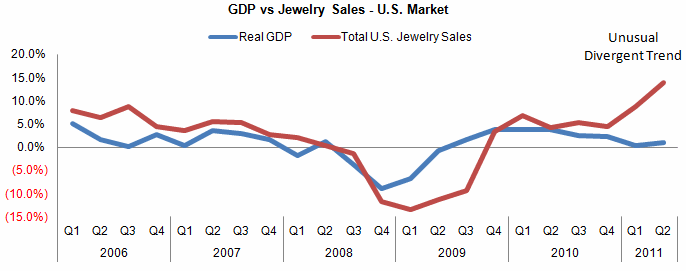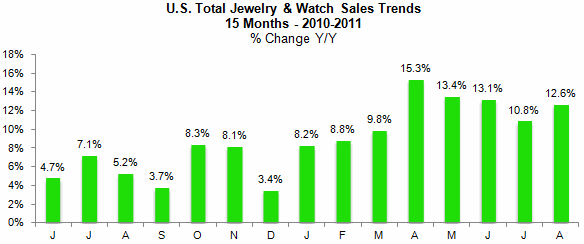IDEX Online Research: Consumer Demand for Jewelry Belies Economic Numbers
October 11, 11
(IDEX Online) – Historically, consumer demand for jewelry in the U.S. market has tracked closely with economic cycles: when the economy is in a growth cycle, jewelry demand soars, and conversely, when the economy slows, jewelry sales decline sharply.
Jewelry sales in 2011 – especially in the second quarter – are not tracking with the economy. While both the U.S. and the global economy are anemic, jewelry demand has remained unusually strong.
The graph below shows the current divergence between jewelry sales and U.S. economic growth.
 Source: BEA & US Commerce Dept. |
Is the current trend an anomaly? Are jewelry sales a leading indicator, suggesting that the economy is about to bounce back? Or, are jewelry sales about to slow notably?
Here’s what the fundamental factors show:
· Most of the drivers of consumer demand are weak.
o Unemployment remains high.
o Wage growth has been modest.
o Consumer credit growth has slowed recently.
o The financial markets are volatile.
o Home prices remain depressed, though they appear to have stabilized.
· Consumers’ moods remain relatively dark and restrained. Logic suggests that depressed consumers would tighten their purse strings.
But, here’s what is important about consumers: watch what they do, not what they say.
Consumer Sentiment Not Important
As illogical as it sounds, jewelers – and other retail merchants – can ignore both the Consumer Sentiment Index and the Consumer Confidence Index as well as just about any other measure of “consumer moods” in the U.S. market. There is almost no correlation between how consumers say they feel and their shopping habits.
Further, European measures of consumer and business sentiment yield the same findings: there is little correlation between glum consumers and curtailed consumer spending.
The consumer sentiment indices measure consumer anxiety about things like a dysfunctional U.S. Congress, saber rattling in the Middle East, swooning stock markets and other things that may spook consumers.
But, as most economists know – and mass media talking heads may not – there is a virtual disconnect between consumer sentiment and retail sales.
In America, there is an old adage: “When the going gets tough, the tough go shopping.”
The best advice for jewelers: watch what consumers do, not what they say.
Economic Factors Weak
The fundamental factors which have an impact on consumer spending remain weak.
· Despite the creation of over 100,000 jobs in September, the unemployment rate remains at 9.1 percent, with about 14 million Americans looking for work, and a larger number who have jobs but are under-employed based on their skill levels and prior job history.
· Personal income – mostly wages – have been rising at a mid-single digit rate this year. U.S. retail sales rose by about 8 percent. Clearly, consumers are spending beyond their income.
· The personal savings has been steady at about 5 percent of total income for the past three years, so the good news is that consumers aren’t dipping into their rainy day funds for daily spending.
· Consumer credit balances rose by 5.9 percent at an annual rate through July. Clearly, consumers have been willing to take on new debt to fund their spending habits. Despite the rise in debt levels, the delinquency rate continues to trend lower, a good sign about the financial strength and debt capacity of the typical American household.
· However, in August, consumer debt growth paused. Interestingly, this did not have an immediate impact on retail sales.
Banks say they have money to lend, and some jewelers report that their consumer credit approval rate is up modestly. But the fact remains: it is difficult to get credit for consumer purchases. The jewelry industry relies heavily on credit availability to drive its sales: rough 50 percent of jewelry sales at the mass market are made on in-house credit (not including credit card sales).
· There are two key measures which affect the Consumer Wealth Factor: the stock markets and home prices. While home prices appear to have stabilized in the U.S., but remain near their bottom, the stock market has been extremely volatile. Thus, consumers are not feeling as wealthy as they have in past years. When consumers feel less wealthy, they usually tighten their purse strings.
What Are Jewelers Saying About Their Sales?
The news from American jewelers has been positive.
· Total U.S. jewelry sales rose by a very strong 12.6 percent in August, based on the latest data available. This was the fifth consecutive month that U.S. jewelry sales have risen at double-digit levels, as the graph below illustrates.
 Source: US Commerce Dept. |
· For August and September, Sterling Jewelers (Kay, Jared, and some regional brands) reported that same-store sales were up 10 percent, slightly below the 12 percent gain for the first two fiscal quarters of 2011, but well above last year’s 9 percent same-store gain for the full fiscal year.
· Zale has reported a string of high-single digit or low-double digit same-store sales gains for the past three quarters.
· Harry Winston just reported that its retail sales continue to show gains in the third fiscal quarter.
· The IDEX Online Research sample of independent specialty jewelers shows that most of them have been reporting solid double-digit sales gains through September.
· Other retail merchants – especially those selling big-ticket infrequently purchased consumer durables – are reporting similarly strong trends. In September, new vehicle sales rose more than expected.
It Is Not All Rosy in Diamond-Land
Among diamantaires, many of the polishers have been selling off their finished goods, and not buying new rough stones. They anticipate a near-term slowdown in consumer demand for diamonds and diamond jewelry.
As a result of reduced demand from cutters and polishers, Harry Winston’s mining operation has eliminated its broad-based diamond sales in the third quarter, and will sell rough diamonds in small lots to selected polished diamond producers from time to time.
Outlook: Consumers Are Fickle
We at IDEX Online Research are trained economists. We watch the numbers. The numbers are not pretty. They suggest that the upcoming 2011 holiday selling season should be slow.
But consumers are fickle: they are unpredictable.
So far, consumers have bucked the economic flow. Shopping mall traffic is up, and consumers are buying goods, even though by historical standards they should have turned off the spending spigot long ago.
What’s going on? Many of us think that American consumers are tired of all the recession rhetoric that they’ve been hearing about for the past four years.
There is tremendous pent-up demand for jewelry, despite unfavorable economic conditions.
Our forecast calls for jewelers to exercise caution: keep inventories modest, promote value and staff stores so that no customer walks away empty-handed.
Despite the numbers and the caution, we are always reminded of this old adage: American consumers are born to spend. Don’t bet against them.